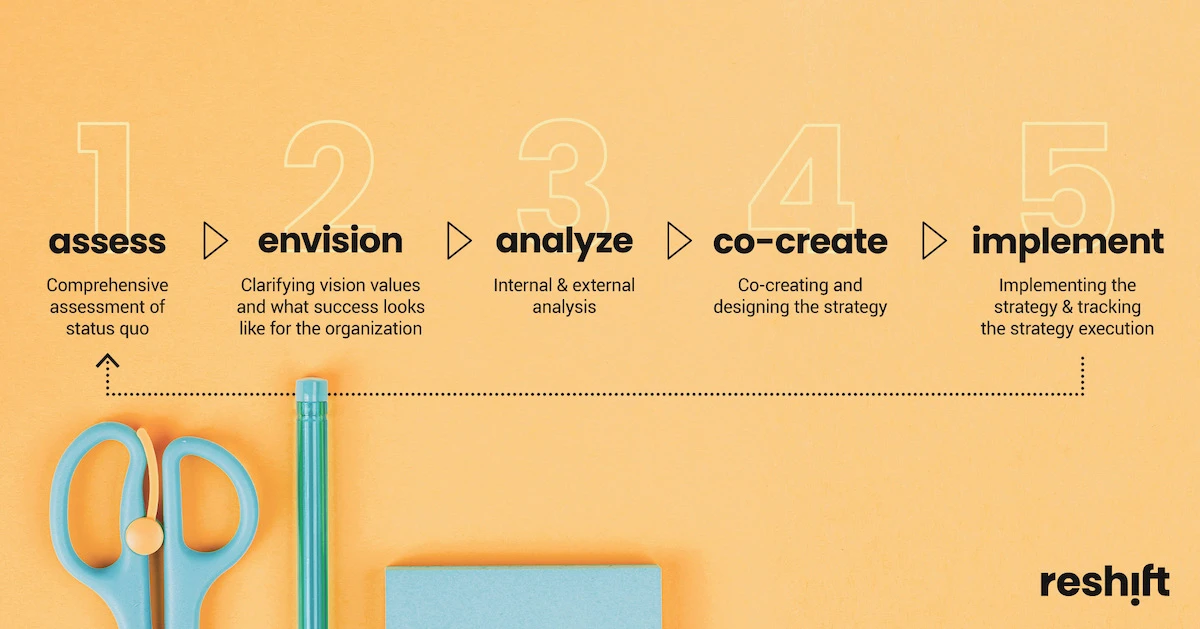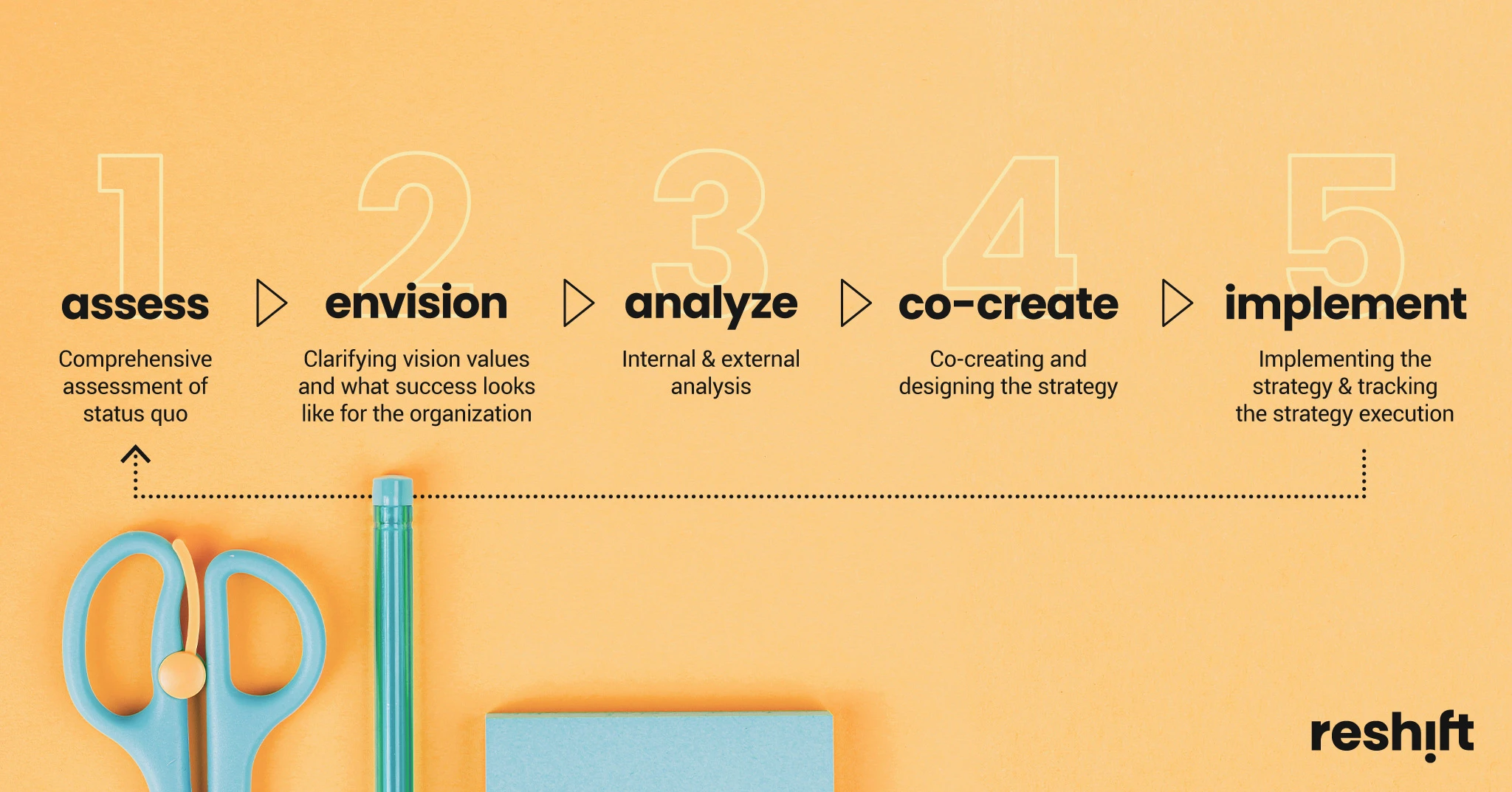Written by Manfred Gollent and Marc Bolick.
Having a documented strategy is foundational to achieving goals, whether it's at the organization level, an operating unit or for a transformation project. At reshift we have a point-of-view about strategy and we share our responses to some of the key questions leaders ask themselves when pondering strategy development.
When asked about the strategy for their business most executives, business owners, and leaders will tell a story describing a strategic direction. When asked more specifically about a documented strategy, in our experience less than 30% of these leaders say they have a documented strategy.
One of the key aspects of leadership is to set a vision, establishing the guiding North Star to which people in the organization aspire. Unfortunately, the vision and strategy are often crafted in isolation with only top leadership input. All too often, the vision is a lofty statement that is not unique to the organization, and worse, it is not connected to a documented strategy that outlines how the vision will be achieved.
Considering that backdrop, let’s explore some facts about an impactful strategy plan.
"Unless a strategy is documented, leadership will tend to subconsciously and unintentionally adapt the strategy to the current situation."
Why is strategy needed in the first place?
The purpose of a strategy is to provide a stabilizing roadmap to guide the organization towards predetermined goals and vision. Strategy is the result of a process of examination of internal and external factors; it takes time and requires input from multiple stakeholders.
Once the strategy development process is completed, the resulting strategy needs to be communicated throughout the organization. This is where documentation of the strategy comes in.
Unless a strategy is documented, leadership will tend to subconsciously and unintentionally adapt the strategy to the current situation. The risk here is that the original intentions of the strategy will be adjusted to the actual results, rather than the strategy providing the framework for achieving the targeted outcomes.
Why is it so important that your strategic plan be documented?
The main reasons to have the strategy written down have to do with how the strategy is implemented and brought to fruition. While the content and the structure are critical for the value of the strategy itself, the actual document serves an additional set of reasons:
- Having a clearly written strategy helps to ensure consistent communication and interpretation of the strategy throughout the organization, as well as with the important stakeholders in the organization’s ecosystem. It helps to generate better alignment of all participants towards the common goals and aspirations.
- A documented strategy acts also as a framework for decision-making. When faced with various options and opportunities, having a clear strategy in place helps leaders and employees make informed choices that are consistent with the organization's long-term objectives, its vision, and its organizational values.
- Furthermore, it provides a basis for performance measurement and evaluation, allowing organizations to track progress towards their goals and identify areas where adjustments or improvements are needed to activate the desired progress.
- External stakeholders, such as investors, partners, and customers, often seek assurance that an organization has a well-thought-out plan for its future. A documented strategy instills confidence in these stakeholders, demonstrating that the organization is proactive and committed to achieving its objectives.
In short, a documented strategy serves as a crucial tool for guiding an organization's actions, facilitating cohesive communication, and ensuring that all efforts are aligned towards achieving common goals. It provides clarity, focus, and direction, which are essential for sustainable growth and continued success.
"If there is no way to measure whether the organization is making progress, the likelihood of achieving the organization’s goals is diminished."
What does a good documented strategy look like?
A good strategy document acts as an “enabling tool” that cohesively engages the organization toward a set of clearly defined goals, fostering organizational focus, and generating meaningful measurements of progress and success.
While it is important that a strategy exists and is documented, the documentation itself needs to be understandable across the organization. Some key characteristics of a good strategy document include:
- “Uncluttered” language
It should be written in a clear and concise manner, avoiding jargon and unnecessary complexity, which will result in a more cohesive interpretation by all relevant stakeholders.
- Alignment of vision, values, mission, and key objectives
The strategy must align with the organization's overall mission and long-term objectives, answering the question of how the organization plans to achieve its defined goals and what actions will be taken to ensure the desired progress.
- Involvement and Ownership
Involving key stakeholders, including employees and management, in the strategy development process fosters a sense of ownership and commitment. Being “invested” in the strategy enhances active contribution to its implementation.
- Scorecard of measurables
The document must provide a scorecard with defined leading and lagging performance indicators to enable the team to guide and track progress. If there is no way to measure whether the organization is making progress, the likelihood of achieving the organization’s goals is diminished.
- Regular Reviews and Updates
A well-defined strategy represents a living framework, not just a document. Regular reviews and updates to the strategy document will ensure its relevance and effectiveness in today’s dynamic business environment.
A strategy document that is clear, actionable, aligned with objectives, flexible, and supported by stakeholders also ensures that the organization remains focused on its long-term vision while being adaptive to changing circumstances in its surrounding ecosystem.
Download our free Vision Toolkit containing a process and tools for crafting your own vision statement
What does strategy development look like?
The development of a strategy is a customized process of preparation and research, systemic thinking, evaluation, and design. While the conceptual process flow provides the basic steps for the planning process, each step itself is customized to the characteristics of the specific organization.
The parameters for customized strategy development are many and include: the type of organization (i.e. a department, a division, an enterprise, even a large transformation project); its size, complexity, geographic dispersion and cultural diversity; the products or services the organization sells; the markets it plays in; and other factors.
Effective strategy planning requires a holistic approach!
It is like building a house, for which it is crucial to establish a “strong foundation”. The foundation of strategy consists of three elements:
- A comprehensive internal assessment to provide keen self-awareness of strengths, limitations, and potential gaps of the organization as well as its individual departments/teams.
- The organizational values, a defined set of principles of engagement. The values represent the non-negotiable framework for decision making and the expected way that individuals engage with one another (and external people) within the organization.
- The vision, a concise description of a desired future state of the organization. The vision functions like a guiding North Star, it provides clarity about the heading of the organization.
Once the foundation is established, the rest of the strategic planning process can take its course very efficiently. At reshift we follow an iterative process that comprises the following five stages:

As we go through this process, we start with a fact-basis from the assessment stage. Only after taking a sober look at the current state can we move into envisioning the future.
The vision then provides an optimistic basis for the team to analyze the critical elements of the organization's strategy. This then sets the stage for the team to co-create and design the strategy together with leadership and key internal and external stakeholders.
Finally, the implementation stage is a continuous cycle of working to a set of goals and plans, tracking and measuring progress and, ultimately, leading back to a new assessment at the beginning of the next stratetgy planning cycle.
How do you get started?
There are several key questions to ask when embarking on a formal strategy planning process:
- Who should lead the strategy planning project? Is the project the initiative of the most senior leader in the organization or unit doing the planning? Having high-level sponsorship for the initiative is extremely important.
- Who should facilitate the process? It is very important to have an experienced facilitator to guide the strategy development process. Do you have someone internally who can take this role (and who can remain in the role of facilitator throughout), or do you need external help?
- Who must be on the planning team? While the overall strategy planning process should include inputs from multiple levels and perspectives within the organization, a core team will have to participate more deeply and devote more time.
Once those questions are answered, the timing, location, budget, and other relevant considerations can be determined and the work of strategy development can begin!
In the coming weeks we will be providing a strategy development toolkit for a DIY approach to getting started with strategy planning. You can be the first to know by signing up for our mailing list here.
Of course, our expert innovation guides are always available to partner with you to co-create your strategy planning project and work through the entire process through to implementation. Let’s talk!
Download our free Vision Toolkit containing a process and tools for crafting your own vision statement
Co-author Manfred Gollent supports successful up-and-coming leaders, C-level executives, CEOs, and business owners in their development towards excellence in leadership effectiveness. Leadership and strategy development is his passion by helping clients to become the most effective leaders and culture innovators they can be! His coaching engagements include all aspects of leadership, strategy, sales & influencing, communication, goal setting, and goal achievement.
Co-author Marc Bolick is founder and managing partner of reshift, an innovation support partner for leaders and teams seeking Big Change. He draws on decades of experience in product and service innovation to facilitate collaborative problem solving and drive impact for the most complex challenges organizations face.

